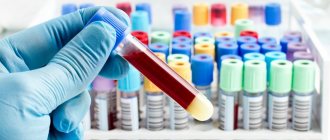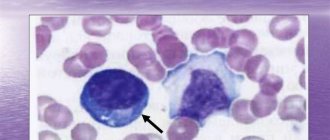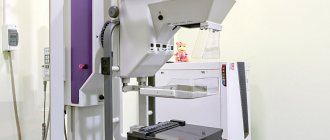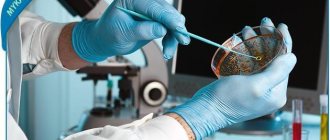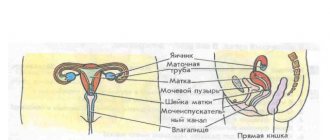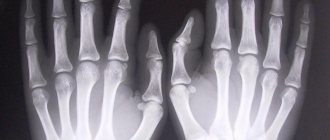Synonyms:
Lactate, Lactic Acid, Lactate
Lactic acid (lactate) is formed as a result of glucose metabolism (glycolysis). It is released from erythrocytes (red blood cells), brain cells and skeletal muscles, after which it enters the blood. The accumulation of lactate in the blood disrupts its acidity and can lead to metabolic acidosis (an imbalance in the acid-base balance in the body).
A biochemical blood test for lactic acid levels allows you to assess the degree of oxidation of body tissues and identify its original causes.
General information
Lactate is a product of cellular metabolism that can be present in the body in the form of lactic acid or its salts (normally its content is minimal). Lactate is utilized by the liver, kidneys, heart, and brain. When there is a deficiency of oxygen in tissue cells, the concentration of lactic acid in the blood increases.
When the so-called “lactate threshold” is reached, when the internal organs do not have time to cope with the volume of lactic acid, lactate begins to accumulate in the body (hyperlactic acidemia). This condition can develop into lactic acidosis (acidification), which the body successfully neutralizes. But in the most severe cases, a violation of the acid-base balance occurs, which is manifested by negative symptoms (weakness, increased breathing, nausea, vomiting, sweating).
Lactic acidosis is divided into 2 types:
Type A - develops against the background of slow blood circulation and insufficient oxygen supply to tissue cells. Type A lactic acidosis accompanies the following diseases:
- severe anemia;
- pulmonary edema;
- cardiovascular failure;
- myocardial infarction;
- sepsis (general infection of the body by pathogenic microorganisms);
- shock due to bleeding or injury;
Type B – occurs when the metabolism of lactic acid is impaired. Examples of type B lactic acidosis:
- diabetes;
- epilepsy;
- renal failure;
- liver pathologies;
- oncological processes (leukemia, lymphoma);
- AIDS;
- severe poisoning with alcohol, salicylates, cyanide, methanol, etc.
Excessive exercise can also release lactic acid.
Under the influence of accumulated lactate, the blood pH changes to the acidic side, which is dangerous to health and requires effective treatment.
To confirm lactic acidosis, a biochemical blood test is performed and 2 components are analyzed: the concentration of lactic acid in the serum, the ratio of lactate and pyruvate.
How is the analysis done?
In order for the results of studies on the concentration of lactate in the blood to be correct, it is important to properly prepare for sample collection and carry out the analysis correctly.
It is recommended to take blood samples in the morning. You must come to the treatment room on an empty stomach; it is important that at least 8, but no more than 14 hours have passed since your last meal. Avoid alcohol and fatty foods the day before.
Before the procedure, you must avoid putting stress on your arm. It is advisable to collect material without applying a tourniquet, or to take blood immediately after applying it.
Indications
- Diagnosis of circulatory pathologies resulting in tissue hypoxia (insufficient oxygen consumption by tissues);
- Assessing the degree of acidosis and prescribing resuscitation measures;
- Detection of diseases of the cardiovascular system;
- Suspicion of non-insulin-dependent diabetes mellitus;
- Determining the cause of lactic acidosis;
- Assessment of the acid-base status of the body and blood pH;
- Diagnosis of asphyxia (severe oxygen deprivation) and enzymopathy (impaired enzyme activity) in newborns;
- Pathological changes in muscles and tissues;
- Differential diagnosis of myopathies (hereditary muscle diseases).
The analysis is deciphered by specialists: endocrinologist, cardiologist, oncologist, traumatologist, surgeon, therapist, pediatrician, etc.
Treatment of abnormalities
This study plays an important role in clinical medicine, since determining the lactate concentration not only shows the degree of hypoxia, but is also a criterion for the timeliness of treatment and prognosis of survival of patients in critical condition. With the test results, you should urgently contact your treating specialist: general practitioner, oncologist, infectious disease specialist, surgeon, therapist or cardiologist. To make the correct diagnosis, the doctor may additionally prescribe OAC, OAM, biochemical tests for urea, creatinine, liver and kidney tests.
To reduce physiological deviations from the norm, it is important to adhere to a diet (reduce the consumption of fatty foods and sweets to a minimum), normalize the drinking regime and reduce physical activity. It should be remembered that during heavy exercise, the lactate content in the blood, caused by hypoxia, can increase 6-9 times compared to normal values.
Increased values (lactic acidosis)
- Pathologies of the cardiovascular system: heart failure, cardiogenic shock (acute left ventricular failure), Raynaud's syndrome (severe vascular disease, spasm of small blood vessels);
- Blood flow disorders and diseases of the circulatory system;
- Non-insulin-dependent diabetes mellitus;
- Increased physical activity (usually among professional athletes);
- Tetany (convulsions due to calcium metabolism disorders);
- Tetanus (a bacterial disease affecting the nervous system);
- Epilepsy (pathology of the nervous system, manifested by convulsive seizures with loss of consciousness);
- Hepatitis (viral inflammation of the liver) in acute form;
- Cirrhosis of the liver (an abnormal change in the structure of the organ tissue);
- Oncological processes: lymphoma (cancer of the lymphatic system), leukemia (blood cancer), etc.;
- Poliomyelitis (highly contagious disease of the nervous system, spinal paralysis);
- Tissue hypoxia (oxygen starvation);
- Hypotension (low blood pressure);
- Heavy bleeding;
- Pulmonary insufficiency, hyperventilation (impaired frequency or depth of breathing).
A temporary increase in lactic acid concentration is possible as a result of:
- deficiency of vitamin B1 in the body;
- long-term regular use of alcohol;
- poisoning with chemical elements: ethanol, salicylates, toxins, methanol, etc.;
- dehydration (dehydration of the body);
- pregnancy (in the 3rd trimester the level of lactic acid may increase slightly);
- taking medications: sodium drug, nitroprusside, adrenaline, metformin, fructose or glucose, propylene glycol, methylprednisolone, phenformin, etc.
What is LDH
Lactate dehydrogenase is one of the enzymes that indicates the presence of damaged cells. It is found both in the blood and in tissues in different quantities. During respiration, lactic acid salts are formed in cells. Lactate dehydrogenase promotes its transition to pyruvic acid, which is involved in the high-energy oxidation process. It promotes the rapid release of energy from glucose, which is necessary for muscle contraction and biochemical processes. The result is products that are easily removed from the body - carbon dioxide and water. If there is insufficient oxygen supply, the enzyme accumulates, causing pathologies that accelerate cell breakdown. They will cause lactate dehydrogenase to be elevated. This indicator is very sensitive to the destruction of cellular structures.
Lactate dehydrogenase, if arranged in order of decreasing quantity, is found in the following organs and tissues:
- In the kidneys.
- Cardiac muscle.
- Skeletal muscles.
- Pancreas.
- Spleen.
- The chemical laboratory of our body - the liver.
- Lungs.
- In blood serum.
The enzyme lactate dehydrogenase has several forms, which differ from each other in isoenzymes, and they are found in different tissues. Depending on the higher concentration of the isoenzyme in a particular organ, there are types of this enzyme:
- LDH-1 – mainly in the heart and blood cells.
- 2 – in leukocytes.
- 3 – in lung tissue.
- LDH - 4 - most of all in the kidneys, placenta, pancreas.
- 5 – found in the liver and striated muscle tissue.
Thanks to this, it is possible to conclude which isoenzyme is responsible for the increased LDH level and determine the disease.
Blood lactate lactic acid role, norm, reasons for increase physiological and pathological
Blood lactate or lactic acid is formed as a result of carbohydrate metabolism, namely: the metabolism of glucose, called glycolysis (the result of the reaction is the formation of pyruvic acid, which, when reduced, gives the final product - lactate), and the process of breakdown of glycogen to glucose - glycogenolysis (the process occurs in liver and muscles and serves as a source of maintaining constant blood sugar levels). In the first case (glycolysis), the reduction of pyruvic acid occurs in the presence of the enzyme lactate dehydrogenase (LDH) and the coenzyme NADH2.
Lactic acid, obtained from the breakdown of glucose, glycogen and individual amino acids, is predominantly concentrated in the tissues of skeletal muscles and leaves them in some pathological conditions or due to intense physical activity (for example, in athletes), transforming into pyruvate in the liver parenchyma or being metabolized in brain tissue and heart muscle. Thus, lactic acid in the blood is a product of glucose utilization.
LDH in children
When it comes to children, the age of the child should be taken into account. LDH levels are higher in children. Also, before going to the doctor, it is necessary to monitor what medications the child is taking and monitor his physical activity. If lactate dehydrogenase is elevated in a child, the reasons may be due to one of the pathologies described above. It should be borne in mind that if the baby is allergic, this can also affect the result, especially with severe childhood eczema or bronchial asthma. Injuries and bruises can distort the analysis, as well as the presence of anemia in the child.
If the first result is higher than normal, it is necessary to retake the analysis to ensure its accuracy. If, however, lactate dehydrogenase is elevated in a child, then a full examination is necessary. This indicator alone does not give the right to make a final diagnosis and prescribe treatment.
Why do you need lactate in the blood and what are its normal levels?
When there is insufficient oxygen supply to cells, lactate is formed during the breakdown of glucose. Once in the blood, this substance can be converted back into glucose. If hypoxia (oxygen starvation) is severe, then a large amount of lactate accumulates in the tissues, which causes a change in the acid-base balance of the blood. This condition is called lactic acidosis.
One of the products of carbohydrate metabolism is lactic acid or lactate. By assessing the blood lactate content, one can judge how saturated the cells and, first of all, muscle cells are with oxygen. A test for the content of this substance allows you to identify disturbances in blood flow, insufficient oxygen supply, acidosis (disturbance of acid-base balance).
Diagnosis of possible violations
Using a blood test for biochemistry, you can diagnose many problems and pathologies in the human body, but deviation from the norm, especially in women, does not always carry a dangerous omen. The same pregnancy can affect many indicators, which should not be considered something bad.
To confirm or refute a possible diagnosis, after deciphering, the attending physician will prescribe additional tests, and also advise which specialists should be visited and what should be changed in lifestyle and diet to restore normal biochemistry parameters.
Tags: woman, blood, lactate, normal
About the author: admin4ik
« Previous entry

